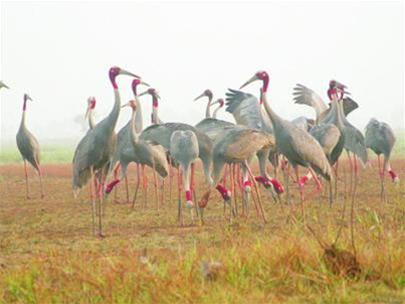Important Grassland Habitats at Tram Chim National Park (Dong Thap) are being restored, providing conditions for the park’s wildlife to recover, particularly the endangered Red-headed Crane, which is making a comeback and showing signs of growth.
Currently, in area A1, the main core of Tram Chim, the area of reed grass (Phragmites australis) is approximately 935 hectares, the area of wild rice (Zizania latifolia) is 242 hectares, the area with a mixture of golden reed and reed grass is 242 hectares, while the pure golden reed area is 31 hectares.

Red-headed Crane at Tram Chim National Park
(Photo credit: Nguyễn Văn Hùng)
Notably, there are about 3 hectares of Indian Head Grass (Sacciolepis striata), a species tolerant of high salinity. The presence of this grass indicates the nearby growth of golden reed, as both species thrive in acidic saline soil conditions. The restoration of grassland habitats is the result of effective hydrological management consistent with wetland ecology, implemented by Tram Chim National Park under the plan “Temporary Water and Fire Management.”
This plan has received support of $100,000 from the project “Conservation and Sustainable Use of Mekong River Wetlands,” with the participation of various multidisciplinary experts both domestically and internationally.
The continuous forest fires at Tram Chim National Park in recent years can be partly attributed to the encouragement of conservation and sustainable use of wetland ecosystems as a special-use forest system. Consequently, these grassland areas have severely degraded due to high water retention in the park throughout the year to prevent fires.
The Melaleuca forest is only a part of the wetland ecosystem and can regenerate after fire. Maintaining high water levels year-round is not suitable for the alternating hydrological regime of the wetland ecosystem in the Dong Thap Muoi region. In fact, it increases the risk of high-intensity fires due to the accumulation of fallen leaves forming a thick layer in anaerobic conditions. Moreover, Melaleuca trees submerged in water for extended periods become undermined, lean over, and develop a cluster of roots around the base, facilitating fire to climb up the trunk and canopy, potentially killing the Melaleuca trees.
















































